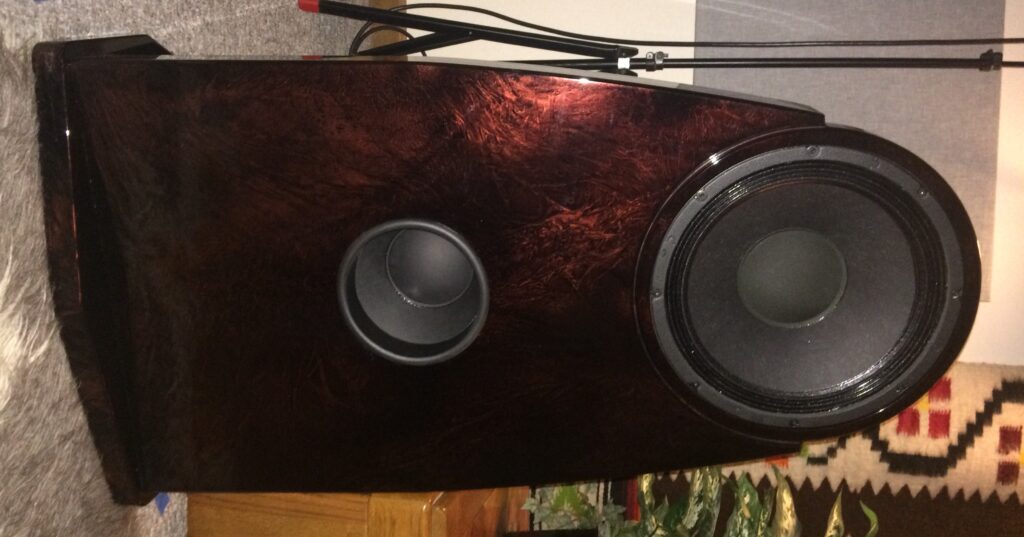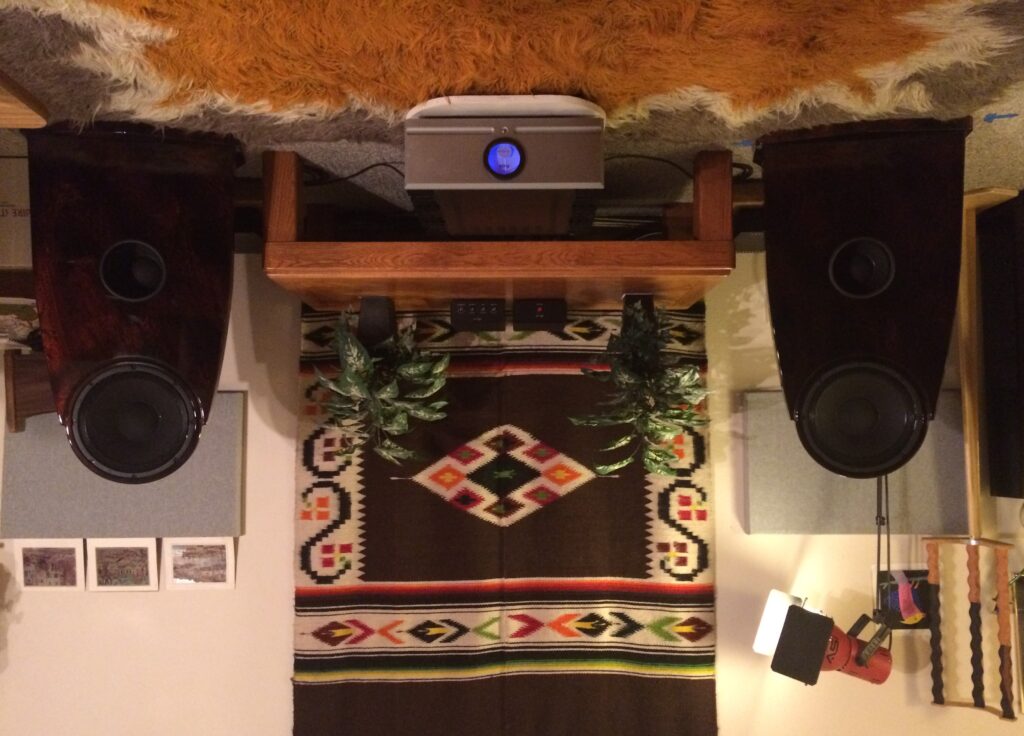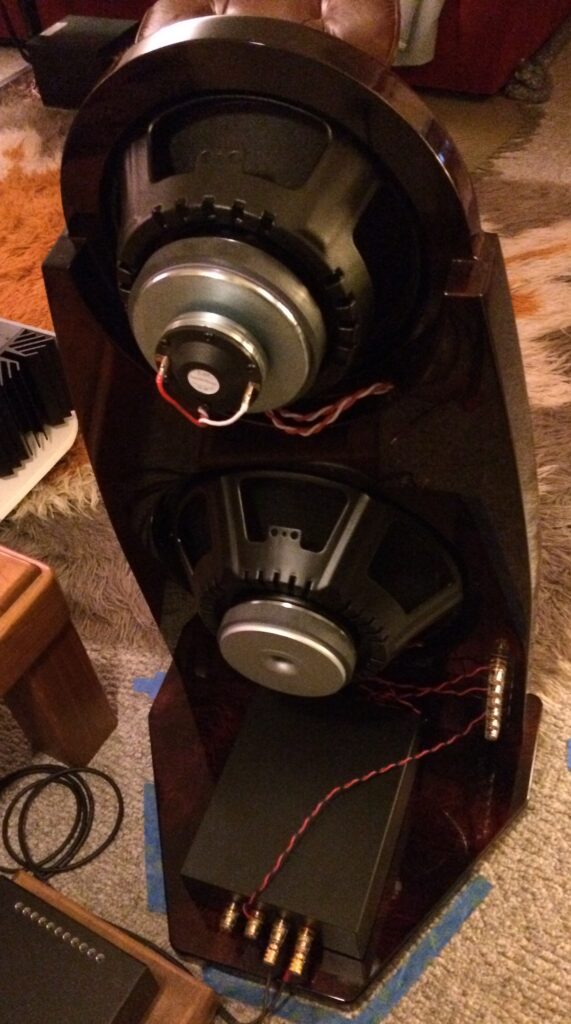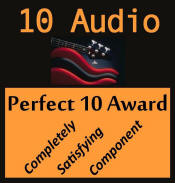The new Emerald Physics EP4.7 loudspeakers will rock your world. Although open baffle technology has been in the public domain for decades, only recently have commercial products become available that use this concept effectively. Open baffle speakers have no enclosure, only a mounting board to which the drivers are attached. This creates a dipole radiation pattern where sound comes from the front, as in a regular box speaker, and also from the rear. The advantages of open baffles are many, not the least of which is the significant cost reduction. An estimated 70-90% of the cost of a common box-type speaker is the box.
There are several other models in the Emerald Physics product line. This model was carefully chosen for review after discussions with Walter Liederman, the proprietor and distributor of Emerald Physics and through Underwood Hi-Fi. I also received – as any customer would – exemplary support from the manager of the product line, Mark Schifter, who has been in the audio business for many years. I requested a full range speaker with superior treble, as I believe that while high quality bass and midrange are certainly necessary, it is the treble range that defines the overall quality of the speaker. The ear is very sensitive to anomalies in the upper frequencies, so it must be not only linear but also offer very high resolution to sound correct and natural.

Emerald Physics includes a small DSP (digital signal processing) box, but since DSP would add a large variable which by design changes the intrinsic sound of the speaker, I asked for a model that includes an analog, passive crossover. The EP4.7 fits all these requirements. It includes a 15 inch woofer, a 12 inch midrange, and a 1 inch polyester dome compression tweeter mounted coincidentally inside the midrange. The basic speaker with tri-coat hand painted finish with three color options, black, anthracite and red, is $6,995 and includes the DSP and “Special Edition” passive crossover. My sample has the upgraded painted Ancient Cocobolo finish, a $1,500 option, which is very attractive. A painted Santos Rosewood finish is another upgrade option. Please use the link below for full specifications.
Components on hand during the review included a VPI Aries 3D turntable with VPI 10” and Kuzma 4-Point 11″ tonearms, AMG Teatro and Miyajima Madake moving coil phono cartridges; RCM Sensor 2, Pass XP-25, Musical Surroundings Nova II, and Jasmine LP3.0 phono preamplifiers; Cary DAC-200ts and Auralic Vega DACs both getting their USB signals from a custom Windows 7 music computer running JRiver Media Center 21, a Bent Audio Tap-X autoformer-based preamplifier, Mark Levinson No. 52, and Spread Spectrum Technologies Theobe II preamplifiers, Acoustic Imagery Atsah, Spread Spectrum Technologies Son of Ampzilla II, and Pass XA30.8 power amplifiers; and Magnepan 3.7, Scansonic MB 3.5, Focal 714 and PSB Image T speakers. Interconnects include Mogami and Audioquest WEL Signature, with Mogami speaker cables and a Wyred 4 Sound USB PCOCC Premium Cable. Power protection and purification are provided by a PS Audio Dectet for the preamplifiers and source components, and a PS Audio Quintet for the power amplifiers. The latter provides remote turn-on and -off of power amplifiers that lack a built-in 12V trigger feature.
Break-in takes a while, which is normal for loudspeakers. Before the tweeters are fully broken in, trumpets can have a kazoo-like quality. At 50 hours, the treble was starting to blend with the midrange. At 100 hours, there was just a trace of treble edge, and the bass was loosening up and becoming more powerful and detailed. The louder you can play music during these early hours, the faster your speakers will break in. They love to be “run hard and put away wet”, which is a reference to horses. For speakers, omit the “wet”. Break in for speakers is not just about hours, it is also about power. They need to be played at your loudest desired levels to fully exercise the suspensions. Expect a 200+ hour break in period for best performance. A rough, prominent treble range slowly fades away and very refined edge-of-audibility resolution takes its place when break in is complete.
Room position does not seem to be critical to getting excellent performance. My room does not offer many choices for position, but all options for toe-in are available. Moving the speakers 1/2 inches laterally makes an audible change. They currently sit with the front panel center at 33 inches from the wall behind, although this distance is not critical. A 30 Hz sound wave is 37 feet long; a 100 Hz sound wave is 11 feet long, at sea level. The distance to the rear wall is therefore, not critical, except as those long sound waves interact with your room. Experiment with toe-in, which is the angle of the speakers from pointing straight ahead (0 degrees) to pointing at each other (90 degrees). About 15 degrees of toe-in seems to offer the most accurate sound stage image in my room.
Ahhh, the sound stage! I had been living with Magnepan 1.7 and 3.7 for a few years and expect speakers that produce a wide, deep and tall virtual stage with performers clearly located on that stage. My expectation was that the stage height would be less with the Emerald Physics speakers than from the Magnepans because of the big difference in the heights of the speakers, but this proved to be incorrect. Apparently, soundstage height is not as simple as how tall the speakers are. Remember Silly Putty? You could flatten it and press it on a newspaper picture to copy the picture. The fun part was to pull the edges and stretch the image, making it elongated and skewed. This is what the Magnepans seem to do: stretch the image. The EP4.7 sonic image is as tall when the recording includes it, but is entirely better focused and more correct. Singers do not appear as a point in space: the EP4.7 is too competent to make the mistake of presenting performers without size and dimensions. Voices are presented as emanating from a human-size head and body, proportional to the recording space.
The focus of individual performers in the sound image is really special and showcases not only the excellent left-to-right image, but also a sometimes awesome sense of depth of the stage which gives body to performers. The entire image is extremely well focused with excellent height, width and depth. This is really where these speakers show their superiority to most every box speaker. The image of the performers of your music earns top marks for believability and lifelike presence.

When the lead guitar solo takes over in Michael Jackson’s “Beat It”, on the Thriller LP, you know what this speaker can do dynamically. Turn it up and be amazed. The 30 Watt (rated power) Pass XA30.8 amplifier could play louder than I ever wanted, while the amp’s power needle barely moved on the loudest peaks.
On the Michael Jackson tribute album This Is It, his singing on “Beat It” occasionally sounds strained, which is correct for this recording. However, the lead guitar solo image is scarily convincing and present. I won’t tell you that the guitar materialized in my room, but the illusion was very strong and substantive. There are constant examples of the ability to clearly allow individual performers to be heard, whether on a live stage or in the studio mix. Following a particular musician’s artistry in a complex mix is available at the listener’s discretion.
The bass range, rated to 28 Hz, from the big 15” woofers is exemplary. There is a strong resemblance to the benchmark-level bass quality of Hartley woofers. I am referring to the big 24 inch models that require huge, room-size enclosures. Their 24” model has a usable frequency range that extends down to 6 Hz! The bass is better than subwoofer quality. With subs, the bass-to-midrange transition suffers from phase shift and a change of character, however small. The EP’s bass is perfectly in tune with the lower midrange because they are both produced by the same driver. The 15 inch drivers can move prodigious amounts of air and give the listener that “punch in the gut” sensation when the music has impactful sounds in the lower frequencies. This instantaneous impact is just not possible from 8” or 10” woofers that must move in and out so far for the same volume level that the leading edge impact is less distinct.
A great bass demo is “Josie” on Steely Dan’s Aja. The slow walking bass line is very audible and apparent, with correct overtones in the upper bass and beyond. The bass is extraordinarily satisfying when the 2nd-6th harmonics are presented by the same driver with all of the quality and character of the fundamental tone intact. This harmonic accuracy is required for performances to sound control-room real. They do!
It is fun to enable a little digital EQ in the low bass. JRiver Media Center makes it easy with the Parametric Equalizer in DSP Studio. A 4 dB boost at 30 Hz seemed to help a few digital recordings. The 15 inch woofers had no problem dealing with the extra bass. The use of this tool above 200 Hz is not recommended because it adds some harshness in the upper frequencies.
The midrange is very human sounding with remarkable resolution. The midrange is similar to the wondrous vocal range of the Tannoy Churchill, with a 15 inch driver, driven by a 300B tube amp. This was a popular combination in the 1990s due the wonderful way it delivered the human voice. If you have ever watched a typical 5-7” midrange driver in action, you have seen the large excursions of the cone. This simply can’t be good for instantaneous changes with low distortion. The Emerald Physics custom 12” cone moves very little. One could argue that a high tech 6” cone has less distortion than a 12” paper-type cone. This might be true at low power levels, but get into the volume range of normal or louder listening and the much smaller movements of a large cone present very well formed voices with uncommon body.
The treble has exceptional resolution which clearly reveals more information than even the excellent Magnepan ribbon tweeter. The other comparison speakers, including the ribbon-tweeted Scansonic, weren’t even close. The Magnepans have a sonic trait where each sound seems to be produced by its own small area of the large driver panels. This helps in overall clarity of the large Magnepan quasi-ribbon or ribbon drivers, but smears the sonic image and makes performers seem larger than they actually are. A large image is nice, but is really only satisfying long-term when point-source technology is employed as in the Emerald Physics speakers.

The differences between the Acoustic Imagery Atsah, Pass XA30.8 and SST Son of Ampzilla II amplifiers are clearly audible. The best results were when the speakers were paired with the Pass amp which worked very well with the speakers’ 95 dB sensitivity. The included DSP was not auditioned as it is RCA only, and my system is all balanced XLR. A balanced DSP is due to be released in the near future and a plan exists for an audition. There were a couple frequency response anomalies with the original passive crossover which a revised crossover, delivered and installed personally by Mark, largely corrected. The EP4.7 is quite neutral with extraordinary resolution. The speakers’ 65 pound weight enables easy movement.
Most speakers, except the biggest, can’t play very loudly without ill effects. And I’m not talking about the sounds of jet planes taking off (140 dB) or live rock concerts (120 dB). I mean normal domestic music, which averages in the mid 80 dB range with peaks in the mid 90 dB range.
Side note: Permanent hearing loss can result from sustained exposure to sounds greater than 90 dB SPL. Monitoring your exposure could be beneficial. Please look into the inexpensive Dayton Audio iMM-6 calibrated mic and maybe the Mobile Tools app from Audio Control, which together can turn your smart phone into a sound measurement instrument. Also recommended is the free NIOSH SPL app (National Institute for Occupational Safety and Health) – search NIOSH SPL.
Logically, one might expect that because of the difference in the radiation pattern between the front-firing tweeter and dipole midrange, the soundstage would change as the frequency increases. Fortunately, logic cannot be trusted here. The image is stable regardless of frequency. The apparent audio picture of musicians performing just a few feet away is very convincing and entertaining. The overall sound is excellent in two ways: by encouraging the listener to tap his or her foot and boogie to the music, and also by satisfying the audiophile penchant for critical listening. You can have and do both with the EP4.7 because it checks off all the marks for deep powerful bass, a tactile and lifelike midrange, and an extended, high resolution treble. The EP4.7 presents an extraordinary sound image that is competitive with anything that this listener has witnessed from any speaker available today. The sound stage presentation is truly outstanding and often stunning that this sonic thing is so present and true that you just smile.
As smaller driver cones and panels start to run out of excursion, they sound compressed (coarse) and distorted. The EP4.7s are able to play louder with greater dynamic range than I can tolerate. This is significantly better than the Magnepan 3.7 even in my small-medium size listening room, and is greater than the usable dynamic range of any of the comparison speakers above. The downside, if you can call it that, is that the listening volumes in my room seem to be increasing for the simple reason that it sounds so damn good.
The EP4.7s also sound very enjoyable at lower than usual volume levels. This can be partially attributed to the excellent bass coupling to the room. The air space behind the speakers is actively driven by the back wave of the big woofers, adding to the power and room pressurization from the front wave of the woofers. All of the air in the room is driven, in phase, at the speaker locations. This effectively provides a sort of acoustic loudness compensation, especially compared to box speakers that often become less efficient at lower frequencies.
The EP4.7 puts the listener in “Koetsu Time”, which is a frame of mind where the music is so captivating that external cares evaporate. The music is so engrossing, often enchanting, that great performances end far too quickly. A five minute song feels as if it concludes in a just a minute or two, and my usual 2-3 hour listening sessions fly by.
The Emerald Physics EP4.7 speakers offer an extraordinarily believable 3D holographic sound stage. They have better than subwoofer-quality bass. The midrange is the complete package. The upper frequencies have state-of-the-art resolution. If you are looking for a full range, high resolution, high-performance speaker then you should hear the Emerald Physics EP4.7. Even if you are prepared to spend (a LOT) more, the Emerald Physics EP4.7 offers exemplary performance and destroys all price-performance ratio benchmarks extant.
They are keepers. I mailed the check and added them to the reference system.
Overall Rating: 10 LPs

Link to manufacturer: Emerald Physics
